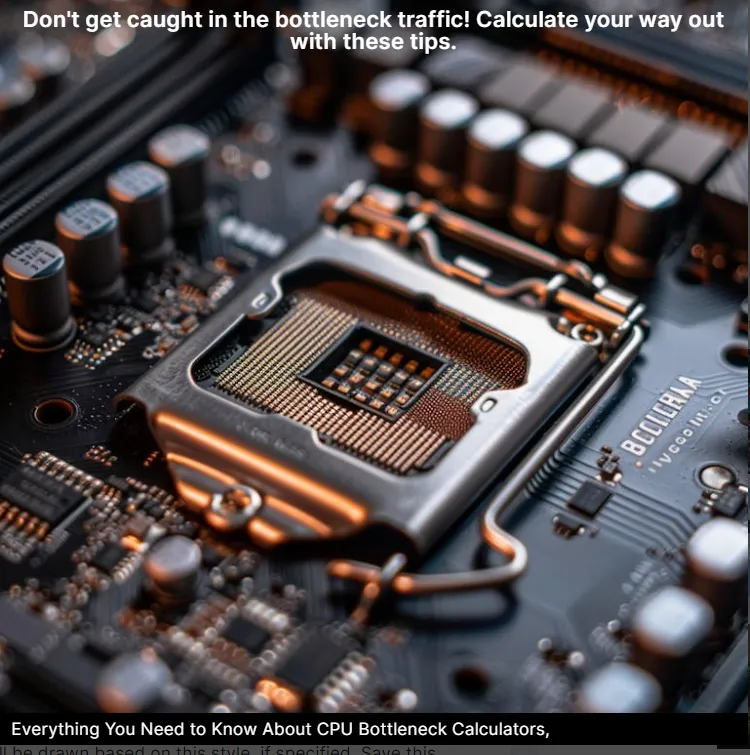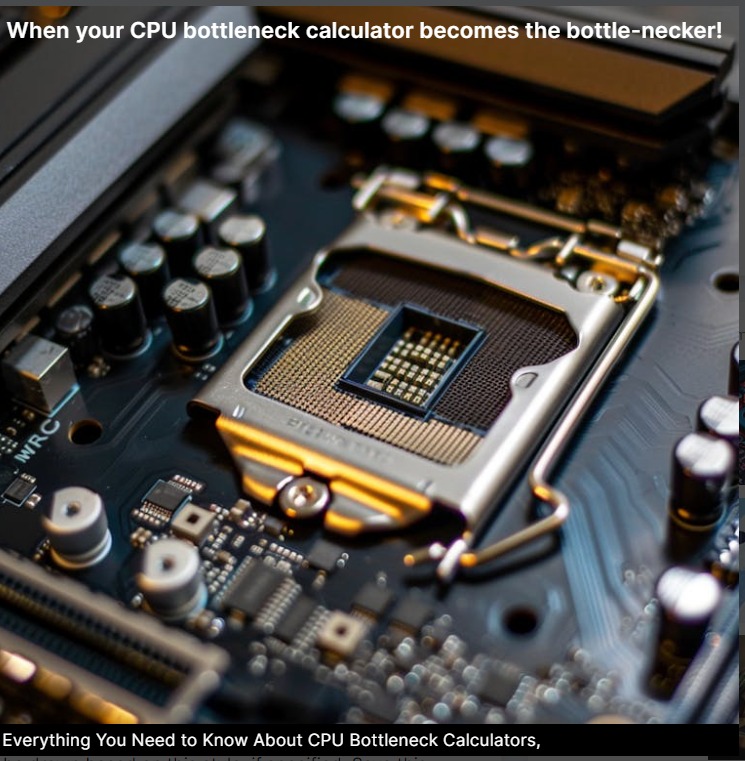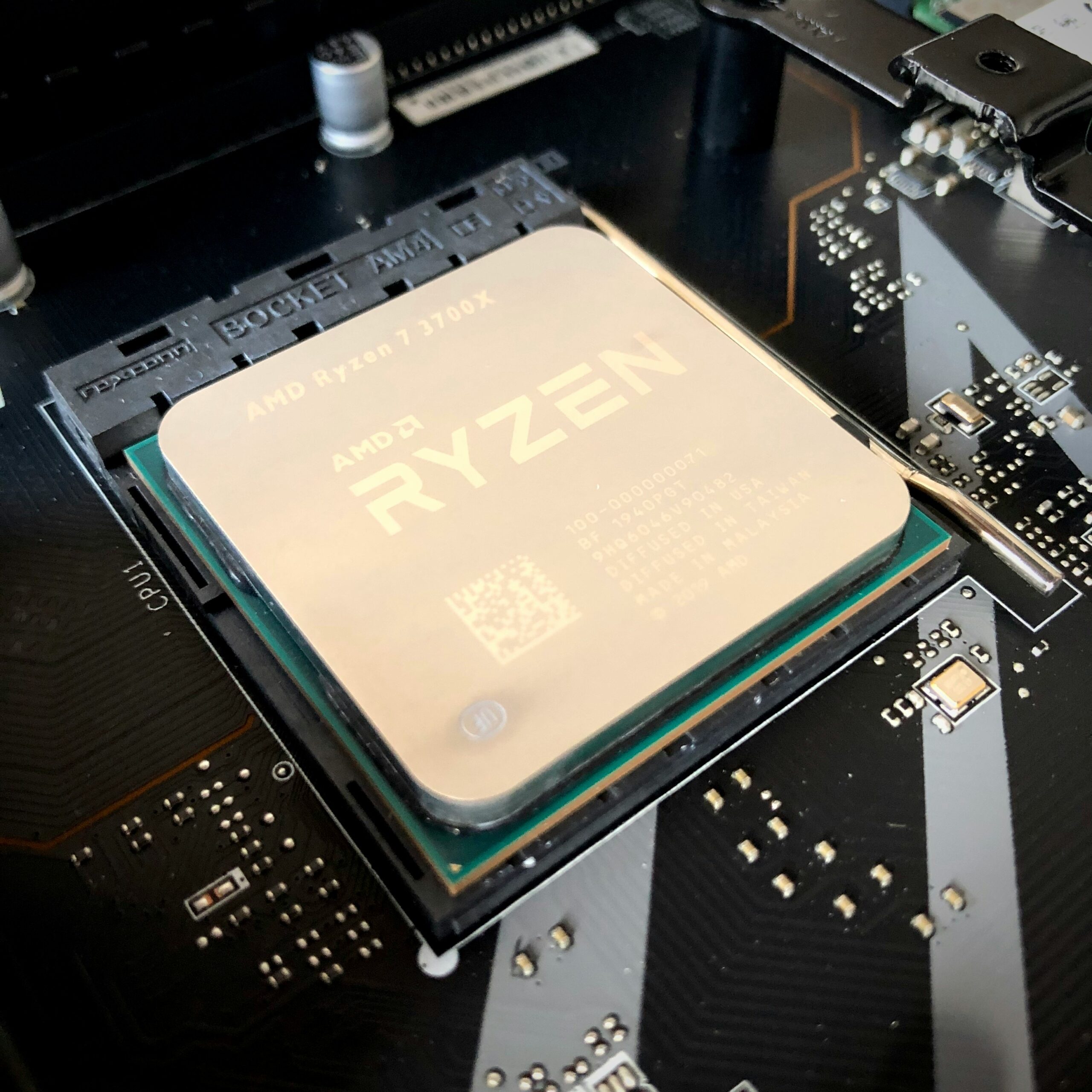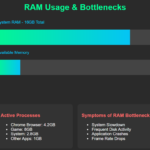CPU Bottleneck Calculators: Discover the essential tool for optimizing your PC. Learn how to identify and fix bottlenecks to boost gaming and performance.
CPU Bottleneck Calculator
0 GFLOPS
GPU Power
0 GFLOPS
CPU Power
0 FPS
Target FPS
| GPU Power (GFLOPS) | CPU Power (GFLOPS) | Target FPS | Bottleneck Status |
|---|
Here’s a step-by-step guide on how to use the CPU Bottleneck Calculator:
CPU Speed (GHz):
Enter your CPU’s speed in GHz (e.g., 3.5).
CPU Core Count:
Enter the number of cores your CPU has (e.g., 4).
CPU Usage (%):
Enter the current CPU usage percentage (e.g., 50).
Game/Application CPU Requirement (%):
Enter the percentage of CPU usage required by the game or application you are running (e.g., 70).
Calculate Bottleneck:
Click the “Calculate CPU Bottleneck” button.
View the Result:
The result will be displayed under the “Calculate CPU Bottleneck” button, indicating whether your CPU is the main bottleneck in your system’s performance, a minor bottleneck, or not a bottleneck.
Introduction to CPU Bottleneck Calculators
CPU bottleneck calculators are invaluable tools for gamers and PC enthusiasts aiming to optimize their computer systems.
A bottleneck in a computer system occurs when one component, such as the CPU, limits the overall performance, causing other components like the GPU to underperform. Understanding and identifying these bottlenecks is crucial to ensure that your system runs efficiently and delivers the best possible performance.
The CPU, or Central Processing Unit, plays a pivotal role in executing instructions and managing the system’s operations.
When the CPU cannot keep up with the demands of other components, it creates a bottleneck, reducing the system’s overall efficiency.
This is particularly significant in gaming and high-performance computing, where balanced components are essential for seamless operations.
Free CPU bottleneck calculators are designed to assess your system’s configuration and highlight potential performance issues. By inputting your CPU and GPU specifications, these calculators can predict whether your CPU will limit the performance of your GPU.
This information is crucial for making informed decisions about hardware upgrades, ensuring that your investments yield the desired performance improvements.
Using a CPU bottleneck calculator can help you avoid common pitfalls, such as pairing a high-end GPU with an underpowered CPU. It provides a clear picture of how different components interact, allowing you to make adjustments that enhance system performance.
These calculators are particularly useful for gamers who seek to maximize frame rates and minimize latency, ensuring a smoother and more enjoyable gaming experience.
In essence, CPU bottleneck calculators serve as a diagnostic tool, enabling users to identify and address performance bottlenecks.
By leveraging these calculators, you can optimize your system configuration, ensuring that all components work harmoniously to deliver peak performance.
Whether you are building a new PC or upgrading an existing one, understanding and utilizing CPU bottleneck calculators is a key step in achieving optimal system performance.

How CPU Bottleneck Calculators Work
CPU bottleneck calculators are essential tools that help users understand the performance dynamics of their PC components.
These calculators utilize complex algorithms and a vast database of hardware specifications to evaluate how well different components, such as the CPU, GPU, RAM, and storage, work together.
By analyzing these interactions, the calculators can identify potential performance bottlenecks that could hinder the efficiency of the system.
The core functionality of a CPU bottleneck calculator involves comparing the processing capabilities of the CPU against the requirements of other hardware components.
For instance, a powerful GPU paired with a mid-range CPU might lead to a bottleneck where the CPU cannot keep up with the data processing demands of the GPU, ultimately affecting the overall system performance.
These calculators measure the computational power required by each component and predict whether the CPU can handle the load without causing delays or slowdowns.
To achieve accurate results, CPU bottleneck calculators rely on a comprehensive database that includes detailed specifications of various hardware components.
This data encompasses processing speeds, core counts, memory bandwidth, and other critical performance metrics.
The algorithms within these calculators cross-reference this information to simulate different workload scenarios, providing a percentage-based assessment of potential bottlenecks.
Moreover, the calculators consider the synchronization between the CPU and RAM, as well as the read/write speeds of storage devices.
If the RAM or storage speeds are significantly lower than the CPU’s processing capability, the tool will flag this as a potential bottleneck.
By offering a holistic view of the system’s performance, these tools enable users to make informed decisions about hardware upgrades or adjustments to achieve optimal efficiency.
Overall, CPU bottleneck calculators serve as a vital resource for both novice and experienced users aiming to fine-tune their PC configurations.
Through detailed analysis and comparison, they ensure that each component operates in harmony, preventing any single part from limiting the system’s overall performance.
Benefits of Using Free CPU Bottleneck Calculators
Free CPU bottleneck calculators offer an array of advantages that cater to both novice and seasoned computer users.
One of the most significant benefits is the ability to save both time and money. When planning to upgrade computer components, making an informed decision is crucial.
Free CPU bottleneck calculators provide users with immediate insights into how different components will interact, helping to avoid costly mistakes and ensuring optimal performance.
Another key advantage is accessibility. Unlike paid alternatives, free CPU bottleneck calculators are readily available to anyone with an internet connection.
This democratizes the process of computer optimization, allowing users who may not have the financial resources for premium tools to still make educated decisions.
The ease of access ensures that everyone, from casual gamers to professional developers, can optimize their systems without additional financial burden.
Ease of use is another compelling reason to opt for free CPU bottleneck calculators. These tools are designed with user-friendliness in mind, often requiring minimal technical knowledge.
This is particularly beneficial for users who may not be well-versed in computer hardware but still wish to enhance their system’s performance.
The straightforward interfaces and step-by-step instructions make it easier to understand the potential bottlenecks and choose appropriate upgrades.
Furthermore, free CPU bottleneck calculators often come with community support. Many of these tools are developed or endorsed by tech enthusiasts who contribute to forums and online communities.
This provides users with a wealth of shared knowledge and practical advice, further enhancing the utility of these free tools. In contrast, paid alternatives may not offer the same level of community-driven support.
Overall, the benefits of using free CPU bottleneck calculators are manifold. They provide a cost-effective, accessible, and user-friendly solution for anyone looking to optimize their computer’s performance.
The added support from online communities makes these tools an invaluable resource for making informed decisions about component upgrades.
Popular Free CPU Bottleneck Calculators
When building or upgrading a PC, understanding potential bottlenecks is crucial to ensuring optimal performance. Several free CPU bottleneck calculators are available online, each offering unique features and user interfaces. Below, we review some of the most popular and reliable ones.
Bottleneck Calculator: This tool is one of the most widely used for assessing CPU and GPU compatibility. It provides an easy-to-use interface where users can input their CPU and GPU models, and it quickly calculates the bottleneck percentage.
The calculator also offers insights into how different resolutions and settings might affect the performance, making it a versatile choice for gamers and professionals alike.
PC Builds Bottleneck Calculator: Another popular option, the PC Builds Bottleneck Calculator, offers a detailed analysis of potential bottlenecks. Users can enter their entire system configuration, including CPU, GPU, RAM, and storage.
This tool not only calculates the bottleneck percentage but also provides suggestions for hardware upgrades to balance the system better. Its comprehensive analysis makes it a valuable resource for both novice and advanced users.
PCPartPicker: Known primarily for its extensive PC building database, PCPartPicker also includes a bottleneck calculator feature. Users can select components from its vast library, and the tool will highlight any potential bottlenecks.
Additionally, PCPartPicker offers price comparisons and compatibility checks, making it a one-stop shop for PC builders. Its user-friendly interface and detailed component information are significant advantages.
These free CPU bottleneck calculators are invaluable tools for anyone looking to optimize their computer’s performance.
By providing detailed analyses and actionable insights, they help users make informed decisions about their hardware configurations.
Step-by-Step Guide to Using a CPU Bottleneck Calculator
Utilizing a CPU bottleneck calculator is a straightforward process that can help you determine whether your CPU is limiting your system’s performance.
Follow these steps to ensure accurate results and actionable insights.
Firstly, gather the specifications of your current system. You will need details such as your CPU model, GPU model, RAM size, and sometimes additional information like storage type and operating system. Having this information readily available will make the process smoother.
Next, open the CPU bottleneck calculator tool of your choice. Many free options are available online, each with a slightly different interface but similar functionality. Typically, you will find input fields where you need to enter your system specifications. Start by inputting your CPU model. This can usually be selected from a drop-down menu or manually typed in. Ensure that you enter the exact model to get the most accurate results.
Following that, enter your GPU model in the corresponding field. Just like the CPU, this can often be selected from a list or entered manually. Be meticulous with this step, as the GPU plays a crucial role in determining whether a bottleneck exists.
After entering the CPU and GPU details, input the amount of RAM your system has. Some calculators also ask for the type of RAM (e.g., DDR4) and its speed (e.g., 3200 MHz). Providing this information can help refine the results. If the calculator asks for additional details like storage type (SSD or HDD) or operating system, make sure to provide accurate information.
Once all the necessary information is entered, proceed to calculate or analyze. The tool will process the data and present you with the results.
These results typically indicate whether there is a bottleneck, and if so, whether it is caused by the CPU or GPU. Some tools may also offer recommendations for upgrading specific components to balance your system’s performance.
To enhance your understanding, refer to any illustrative graphics or screenshots provided by the calculator. These visual aids can help you better interpret the results and comprehend the suggested improvements.
By following these steps, you can efficiently use a CPU bottleneck calculator to diagnose potential performance issues in your system and make informed decisions on necessary upgrades.
Interpreting Bottleneck Calculator Results
When using a CPU bottleneck calculator, understanding the results is crucial to making informed decisions about your computer hardware.
The calculator typically provides a detailed analysis of your current system configuration, highlighting potential areas where your CPU, GPU, or other components may be causing performance issues. Let’s delve into some of the common terms and metrics you will encounter.
One of the primary metrics is the percentage bottleneck. This figure indicates the extent to which one component is limiting the performance of another.
For instance, if your CPU is reported to have a 20% bottleneck, it means that it is holding back 20% of the performance potential of your GPU.
A lower percentage is generally better, indicating a more balanced system where all components are effectively utilized.
Performance ratios are another important aspect. These ratios compare the relative performance of your CPU and GPU.
A balanced ratio often suggests that your components are well-matched, whereas significant disparities might indicate that one component is either too powerful or too weak relative to the other. Striving for a balanced performance ratio can help ensure smoother and more efficient operation.
Component compatibility is also highlighted in the results. The calculator will assess whether your CPU and GPU are compatible with each other and with other system components.
Incompatibility can lead to suboptimal performance or even system instability. Ensuring that all parts of your system work harmoniously together is essential for achieving optimal performance.
Armed with this information, you can make more informed upgrade decisions. If a significant bottleneck is identified, you might consider upgrading the limiting component.
For example, if your CPU is the bottleneck, upgrading to a more powerful processor can help unlock the full potential of your GPU.
Conversely, if your GPU is identified as the bottleneck, investing in a more advanced graphics card might be the solution.
In summary, by understanding percentage bottlenecks, performance ratios, and component compatibility, you can use the insights from a CPU bottleneck calculator to optimize your system.
This knowledge enables you to make strategic upgrades, ensuring a well-balanced and high-performing computer setup.

Common Misconceptions About CPU Bottlenecks
When discussing computer performance, the term “CPU bottleneck” often arises, frequently leading to several misconceptions.
One prevalent myth is the overemphasis on CPU performance as the sole determinant of a system’s efficiency. While the CPU is indeed crucial, it is merely one component in a complex system.
Other hardware elements, such as the GPU, RAM, and storage, also play significant roles in overall performance.
Focusing solely on the CPU can result in an unbalanced system where other components do not match up, leading to inefficiencies.
Another common misconception is the belief that upgrading the CPU will always resolve performance issues. In reality, a bottleneck can occur anywhere in the system, and enhancing the CPU alone might not yield the desired improvements. \
For instance, a high-end CPU paired with an outdated GPU will still face performance constraints.
Therefore, it is essential to evaluate the entire system and identify the true source of the bottleneck rather than assuming the CPU is always at fault.
Furthermore, the role of software in affecting system performance is often overlooked. Optimized software can significantly reduce the load on the CPU and other components, while poorly optimized applications can cause undue strain, misleading users into thinking that hardware upgrades are necessary.
Additionally, varying workloads and usage scenarios can influence the effectiveness of hardware components.
For example, tasks like gaming and video editing place different demands on the CPU and GPU, necessitating a balanced approach in system configuration.
Bottleneck calculators, while useful tools, should be employed with a comprehensive understanding of their limitations.
These calculators provide estimates based on average data and may not account for specific use cases or individual system configurations.
Users should use bottleneck calculators as a starting point and supplement this information with further research and real-world testing to make informed decisions about their hardware upgrades.
Conclusion and Final Tips
Throughout this blog post, we have delved into the significance of free CPU bottleneck calculators, elucidating their role in diagnosing and optimizing your PC’s performance.
These tools are invaluable for identifying mismatched components that could be hampering your computer’s efficiency.
By understanding the interplay between your CPU and other hardware components, you can make informed decisions about upgrades and modifications.
Regular system maintenance is crucial for ensuring optimal performance. Keeping your operating system and drivers up to date can prevent many common issues and enhance overall stability.
Additionally, regularly cleaning your hardware, such as dusting out your CPU and GPU, can prevent overheating and maintain performance levels.
Staying abreast of the latest hardware trends is also beneficial. Technology evolves rapidly, and new components offering improved performance at lower costs frequently enter the market.
By keeping an eye on industry developments, you can make timely upgrades that align with your performance needs and budget constraints.
Continued learning about computer components and their interactions is another key aspect of maintaining a high-performing system.
Resources such as forums, online courses, and tech blogs can offer valuable insights and tips from experts and fellow enthusiasts.
This knowledge can empower you to troubleshoot issues more effectively and make better decisions regarding future upgrades.
In conclusion, free CPU bottleneck calculators are essential tools for anyone looking to optimize their PC’s performance.
By regularly using these calculators, staying updated with the latest trends, and committing to continuous learning, you can ensure that your system runs smoothly and efficiently.
With these strategies, you’ll be well-equipped to tackle any performance issues and keep your computer in top condition.





